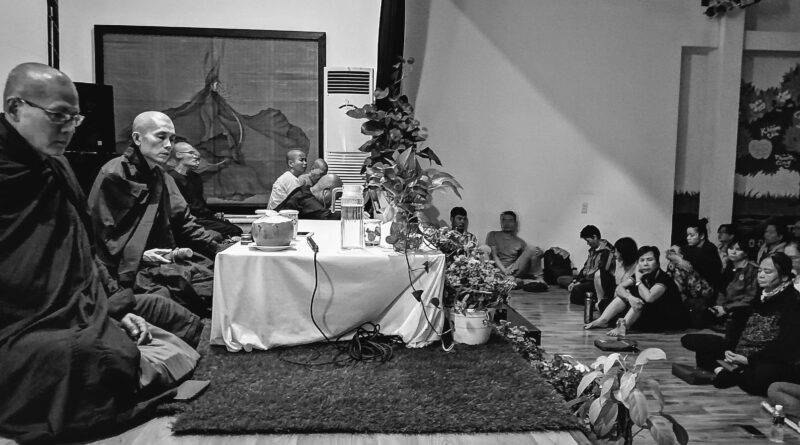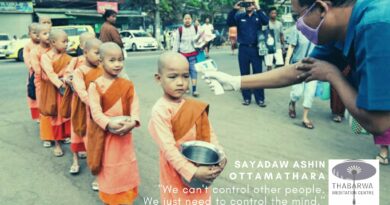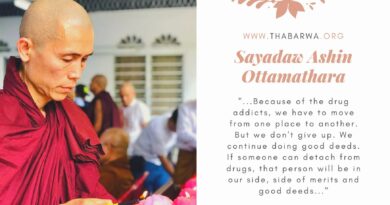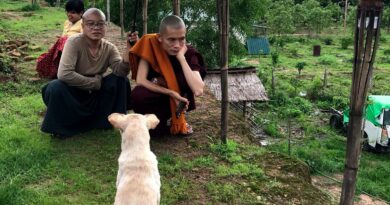CHÁNH NIỆM XẢ LY – BẢN CHẤT CỦA HÀNH THIỀN
“Khi hành thiền chúng ta nên chấp nhận sự thật rằng không có người, chẳng có vật, không tôi, không bạn, không có cái của bạn, không có chúng sinh hữu tình, chẳng có chúng sinh vô tình, chỉ có bản chất vô thường. Đừng bao giờ quên Sự Thật này. Sự thật là Tự Nhiên. Và Tự Nhiên mang trong mình những quy luật:
Có ba loại hành động thân, khẩu và ý. Trong ba loại hành động này có hành động thiện và hành động bất thiện. Hành động thiện mang lại quả thiện: sống thọ, khỏe mạnh, trí tuệ, nhân từ, khoan dung. Tất cả những phẩm chất tốt là kết quả của hành động thiện. Đoản mệnh, đau yếu, thiểu trí, ngu dốt, bần cùng… là những hệ quả của hành động bất thiện. Để có được những điều tốt đẹp, ta cần chú trọng làm điều thiện, cả về thân lẫn về tâm. Ta nên cẩn trọng trong hành động, lời nói và ý nghĩ. Ta cần phải lưu ý đến những tư tưởng ta dung chứa trong tâm, cả tư tưởng thiện lẫn bất thiện.
Mọi người đều nên thực hành thiền, không phải riêng Phật tử, nhà sư, tu nữ hay những thiền sinh. Hành thiền không chỉ là thực hành ở thiền đường hay trường thiền; ta cũng cần thực hành ở nhà, trường học, bệnh viện, cơ quan, khi lái xe… Việc bắt đầu tại trường thiền và tại một khóa thiền như thế này sẽ thuận lợi hơn vì có những thiền sinh khác và được dẫn dắt bởi thiền sư. Nếu không thể tự thực hành, bạn nên đến những khóa thiền để gặp gỡ và hành thiền cùng những người khác. Một khi đã thực hành tại trường thiền, bạn sẽ có thể hành thiền tại nhà, với bất kì ai, tại mọi thời điểm, mọi nơi chốn.
Bản chất của hành thiền là chánh niệm và xả ly. Bạn nhất định phải giữ chánh niệm trong tâm. Tâm trong thời khắc hiện tại nhất định phải trong trạng thái chánh niệm và sẵn sàng để xả ly. Chánh niệm với sự dính mắc thì không trọn vẹn. Khi bắt đầu, bạn cũng có thể hành thiền với dính mắc về nơi chốn, về bạn đạo, người thầy và về bản thân nhưng bạn cần nhận thức rõ về sự hiện diện của dính mắc đó trong thời khắc hiện tại. Không chánh niệm, bạn sẽ chẳng thể biết về dính mắc của mình. Chỉ khi giữ được chánh niệm bạn mới biết được về những nỗi sợ hãi, nghi kị, lo lắng… của mình.
Bạn có thể hiểu về điều này nhờ đọc Kinh điển Phật giáo hoặc lắng nghe pháp thoại, nhưng điều này chỉ đáp ứng một phần. Bạn cần phải biết bằng chính sự thực hành. Khi hành thiền ta có thể giữ chánh niệm trong mọi lúc. Bạn cần giữ chánh niệm trong mỗi hành động, trong mỗi bước đi, trong mỗi thời khắc. Đối tượng của chánh niệm phải là chính ta, không phải ai khác. Nếu không thể chánh niệm ta chẳng thể hiểu được chính mình, về việc mình đang làm. Ta luôn quan tâm đến gia đình, con cái ta hoặc công việc của mình. Chỉ trong chánh niệm, ta mới có thể biết được sự thật về chính bản thân mình.”
Thiền sư Sayadaw Ashin Ottamathara
Pháp thoại tại Trường Tuệ Đức [Tiếng Việt – English – Italiano]
TP.HCM, Việt Nam – 20/12/2019
Nguồn: Facebook Thiền sư Ottamathara
————-
Teaching at Tue Duc international school
20 Dec 2019 HCMc, Vietnam
“When we meditate, we should accept the truth which is not something not someone, no I, no you, not mine, not yours, not living beings, not non living beings, just impermanent nature. We should not forget this natural truth. The Truth is Nature. There are also natural law.
There are both good and bad actions.
There are 3 kinds of actions: verbal, mental and physical actions. In these 3 actions, some physical are bad, some are good. So also some verbal or mental actions are good and some are bad. Good actions are causes of good results : long life, health, intelligence, kind heart, generosity. All these good qualities are result or consequence of god actions. Not long life, not healthy, not intelligent, stupid, stingy, these are consequences or results of bad actions. If we want to have what is good we should emphasise to do what is good not only with our body but also with or mind. We should be careful whatever we do whatever we say and think. We should be careful whatever we accept in the mind whether it is good or bad.
Meditation is for all. Not only for Buddhist, not only for monks, nuns and meditators. Besides meditation is not only to practice in Dhamma hall or meditation center; we need to practice at-home, at school, at hospital, at our business, when driving. But if we start in the meditation center, in a retreat like now with a meditation master and other meditators it’s easier. If we cannot meditate by ourselves we should go to retreats and meditate along with masters and other meditators. If we are able to meditate with meditators in meditation center we should continue to practice at-home, we should practice with anyone, any time and everywhere. The real meditation is Mindfulness and detachment.
The mind must be mindful. The mind we are using at present moment must be mindful and need to detach. Mindfulness with attachment is not complete. At begining we can meditate with attachment for the place, for meditation, for the master, for ourselves but we must know the truth of the attachment happening at the present moment. If we are not mindful we cannot know our attachment. Only if we are mindful we can know our worries, fear, doubt, etc.
We can understand like this by reading Buddhist literature or listening talks, this is not enough. We need to know by our own practice. When we practice meditation we need to be mindful all the time. Whatever we do we must be mindful, wherever we go we must be mindful, whatever time it is we must be mindful. The object of mindfulness must be ourself, not the others. If we are not mindful we may not know about ourselves, what we are doing now. Most of the time we may be careful about our parents or children or our job. Only when we are mindful we can know about the truth of ourselves.”
– Sayadaw Ashin Ottamathara –
————————-
[Italiano]
20 dic. Ho chi Minh city (Vietnam)
“Quando meditiamo dovremmo accettare la verità che non è qualcosa che non è qualcuno, no io, no tu, non mio, non tuo, non esseri viventi, non esseri non viventi, solo natura impermanente. Non dovremmo dimenticare questa verità naturale. La verità è la natura. Ci sono anche leggi naturali.
Ci sono azioni buone e cattive.
Esistono 3 tipi di azioni: azioni verbali, mentali e fisiche. In queste 3 azioni, alcune sono cattive, altre sono buone. Quindi anche alcune azioni verbali o mentali sono buone e altre sono cattive. Le buone azioni sono cause di buoni risultati: lunga vita, salute, intelligenza, cuore gentile, generosità. Tutte queste buone qualità sono il risultato o la conseguenza delle azioni buone. Non lunga vita, non salutare, non intelligente, stupida, avara, queste sono conseguenze o risultati di cattive azioni. Se vogliamo avere ciò che è buono, dovremmo enfatizzare di fare ciò che è buono non solo con il nostro corpo ma anche con le parole o con la mente. Dobbiamo fare attenzione a tutto ciò che facciamo qualunque cosa diciamo e pensiamo, dovremmo essere attenti a tutto ciò che accettiamo nella mente, sia esso positivo o negativo.
La meditazione è per tutti. Non solo per buddisti, non per monaci, monache e meditatori. Inoltre la meditazione non è solo pratica nella sala del Dhamma o nel centro di meditazione; dobbiamo esercitarci a casa, a scuola, in ospedale, nella nostra attività, quando guidiamo. Ma se iniziamo un centro di meditazione, in un ritiro come ora con un maestro di meditazione e altri meditatori è più facile. Se non possiamo meditare da soli, dovremmo andare ai ritiri e meditare insieme a maestri e altri meditatori. Se siamo in grado di meditare con i meditatori nel centro di meditazione, dovremmo continuare a praticare a casa, dovremmo praticare con chiunque, in qualsiasi momento e ovunque. La vera meditazione è Mindfulness e distacco. La mente deve essere consapevole .. La mente che stiamo usando in questo momento deve essere consapevole e deve staccarsi. La consapevolezza con attaccamento non è completa. All’inizio possiamo meditare con attaccamento per il luogo, per la meditazione, per il maestro, per noi stessi, ma dobbiamo conoscere la verità dell’attaccamento che accade nel momento presente. Se non siamo consapevoli, non possiamo conoscere il nostro attaccamento. Solo se siamo consapevoli possiamo conoscere le nostre preoccupazioni, la paura, il dubbio, ecc.
Possiamo capire in questo modo leggendo la letteratura buddista o ascoltando i discorsi, questo è un po ‘abbastanza. Dobbiamo sapere con la nostra pratica. Quando pratichiamo la meditazione, dobbiamo essere sempre consapevoli. Qualunque cosa facciamo, dobbiamo essere consapevoli, ovunque andiamo, dobbiamo essere consapevoli, qualunque sia il momento, dobbiamo essere consapevoli. L’oggetto di Mindfulness deve essere noi stessi, non gli altri. Se non siamo consapevoli, potremmo non sapere di noi stessi, cosa stiamo facendo ora. Il più delle volte possiamo stare attenti ai nostri genitori o figli o al nostro lavoro. Solo quando siamo consapevoli possiamo conoscere la verità di noi stessi.”
– Sayadaw Sayadaw Ashin Ottamathara –







